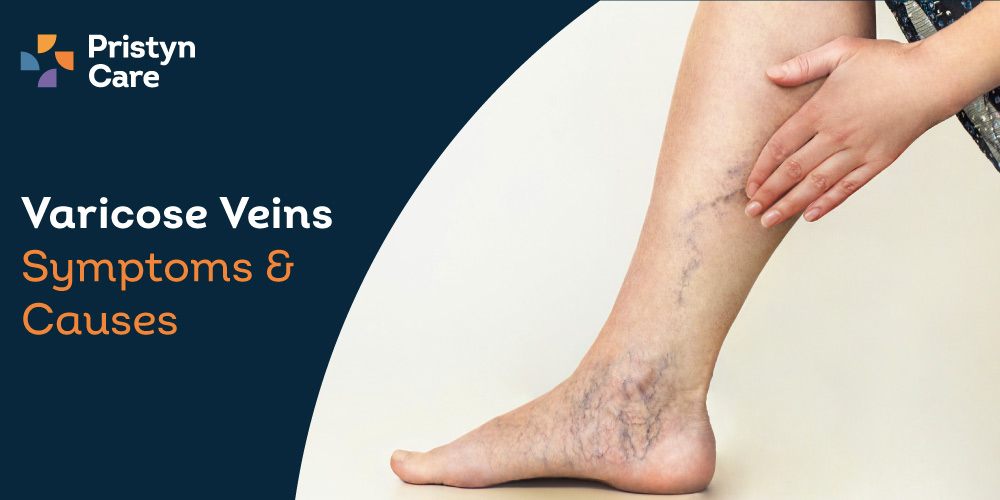![]() Views: 598
Views: 598
Varicose Veins Symptoms and Causes
This dysfunction is generally caused due to pressure on the veins of certain parts of the body (mostly legs and thighs), which causes the blood to flow back to the heart. When the valves get damaged, the blood pools or travels backward, causing the veins to turn blue or dark purple, appear on the skin, and cause other symptoms as well. .
Dedicated Support at Every Step!
Our Doctors are available 24 hours a day, 7 days a week to help you!
Table of Contents
What is Varicose Veins?
While varicose veins are common on the legs or thighs, they can also occur on other body parts. The condition isn’t problematic in the initial stages, but it can lead to life-threatening complications, including Pulmonary Embolism, if it turns severe. Let us now understand the symptoms and causes of varicose veins.
No Cost EMI, Hassle-free Insurance Approval
Varicose Veins Symptoms
As mentioned above, varicose veins do not lead to any complications in the initial stage. Most people with this condition can go about their daily lives easily without experiencing any discomfort. However, others might experience painful symptoms that can affect their day-to-day lives. The primary symptoms of this vascular condition include:
- Dark blue or purple veins beneath the skin.
- Bulging veins, or veins that appear to be swollen or rope-like, are accompanied by tiny red veins or ‘spider veins’ They can also appear in clusters right beneath the surface of your skin.
- Heaviness or a feeling of tiredness in the legs, especially after indulging in physical activity such as walking, exercising, etc.
- A dull pain in the affected area, in addition to muscle cramps. These concerns generally flare up in the legs or the area behind your knees.
- Some patients complain of experiencing itchiness and redness around the affected veins.
- Increased swelling and throbbing in the legs, ankles, and feet.
- Discoloration of the skin and ulcers or sores on the skin.
If you notice any of the varicose veins symptoms mentioned above, immediately get in touch with your healthcare provider to prevent potentially life-threatening complications.
Causes Of Varicose Veins
Varicose veins occur when the valves within the veins get damaged. Excessive pressure on a specific body part is often the leading cause of this damage, as it disrupts the normal blood flow and causes it to flow back towards the heart. Some other factors that may lead to this condition include:
- Hormonal issues
- Obesity/ Excessive weight
- Aging
- Wearing clothes that are too tight
- Standing or sitting in the same position for prolonged periods.
What Are The Risk Factors For Varicose Veins?
Certain factors put you at a higher risk of getting varicose veins, including:
- Your gender: Women are at an increased risk of developing this condition. Female hormones may cause the walls of the veins to stretch. Additionally, pregnancy or taking birth control pills changes hormone levels and increases the risk of this condition.
- Family history of varicose veins: If this condition runs in your family, there’s a chance that you might inherit it.
- Your age: As you age, the vein's valves lose elasticity, stiffen, and do not function normally. This can also lead to varicose veins.
- Lifestyle habits: Standing or sitting in the same position for too long, such as while traveling, also increases the risk of varicose veins. This happens due to a decrease in blood circulation. Similarly, if you wear restricted clothes, such as clothes with tight waistbands, etc., you might develop this condition.
- Health conditions: Constipation or certain tumors also cause increased pressure on the veins and may lead to this condition.
- Having an unhealthy body weight: If you’re obese or overweight, you’re more likely to develop this condition.
Can You Prevent Varicose Veins?
While you can’t prevent varicose veins from occurring, you can definitely alter your lifestyle habits to reduce the risk of developing this discomforting condition. Here are some tips to prevent this condition from occurring in the first place:
- Elevate your legs to increase blood flow to the heart. Raise your feet above your waist to allow blood to flow seamlessly.
- Refrain from standing or sitting in the same position for too long. Stretch or take short walks in between.
- Keep your body weight in check. Excess weight increases pressure in your blood vessels. Maintain a healthy body weight to avoid that, and in turn, prevent varicose veins.
- Wear properly fitting clothes. Loose clothes allow unrestricted blood flow. Avoid pants, or other garments with tight waistbands.
- Compression stocking to the rescue. These stockings compress your veins, and help blood flow. This prevents the condition from occurring, or becoming worse.
Also Read:
- Different Diagnostic Test Methods For Varicose Veins With Their Costs
- What Is The Difference Between Spider Veins And Varicose Veins?
- What Is Varicose Veins ICD 10 Code? All Things You Need To Know










